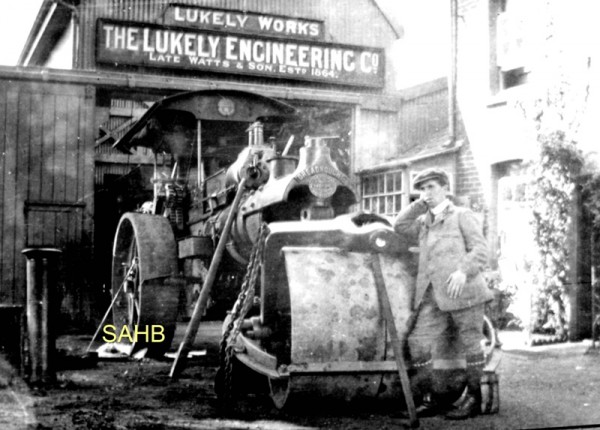
From the look on the face of the gentleman propping himself up in front of this steam roller it could be thought that his foot was trapped beneath it, but that is not the case. Although we can only speculate about what prompted his morose expression, and cannot find any reference to the Lukely Engineering Company either, some information about the vehicle itself can at least be provided.
A single-cylinder machine, probably of 7 nominal horsepower, and weighing around 10 tons, it was made in 1909 by Wallis & Steevens of Basingstoke, Hampshire, and on the oval maker’s plate above the roller pivot the number 7094 can be read in the original photograph. This suggests that the firm had been fairly busy since commencing its activities some 40 years earlier. Like most vehicles of this type it bore a name, in this case it was ‘Dreadnought’, probably called after the battleship HMS Dreadnought that was to become the Royal Navy’s flagship. This was launched in February 1906 having been built in the Portsmouth Dockyard, only just across the waters of the Solent from where this road roller came to reside.
On the 23rd September 1909 this new machine came into the ownership of Messrs T Knighton & Sons of Newport, Isle of Wight, and by 1921 it belonged to one Reginald Wells, also of Newport, to whom it was registered as DL-2164. Somehow it later found its way to Bishopsbrigg in Lanarkshire where it was eventually scrapped in 1950.
Although as seen here, and referred to above, as being a ‘road roller’, the vehicle was in fact a ‘convertible’, this being a traction engine that could be changed into a roller, or vice versa. Wallis & Steevens had first introduced a machine of this type in 1890, but they were never by any means common. According to the member of the Road Locomotive Society who kindly supplied the SAHB with the ownership details of this machine, whilst there are illustrations in various maker’s catalogues showing how the transformation could be made, no photograph of conversion work actually in progress has previously been seen. So this is a rather special snapshot.
Maker’s of such vehicles referred to the conversion process as being ‘simple’, but apparently it was far from being so, and it was also time-consuming. Perhaps that is the reason for the gentleman in the picture looking rather disenchanted.






